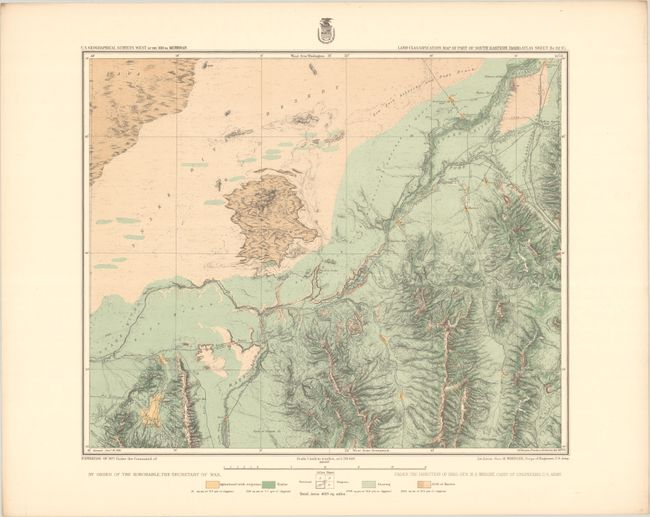Current Auction
"[Lot of 2] Parts of Southern Idaho & Northern Utah Atlas Sheet No. 41 (A) [and] Land Classification Map of Part of South Eastern Idaho. Atlas Sheet No. 32 (C.)", Wheeler, George (Lt)
Subject: Southern Idaho & Northern Utah
Period: 1880-81 (dated)
Publication: U.S. Geographical Surveys West of the 100th Meridian
Color: Printed Color
Size:
18.4 x 15.1 inches
46.7 x 38.4 cm
Download High Resolution Image
(or just click on image to launch the Zoom viewer)
(or just click on image to launch the Zoom viewer)
The 1870s was a period of intense effort, by such prominent people as Clarence King, Ferdinand Hayden, and John Wesley Powell, to advance the geographical knowledge of the West. These various surveys presented a threat to the Army's supremacy in the field of mapping and to the related appropriations from Congress. As a result of these pressures, the Army Corp of Engineers developed a plan to systematically survey the entire West to be called the U.S. Geographical Surveys West of the One Hundredth Meridian. The region was divided up into 95 rectangles, with atlas sheets to be prepared for each, comprising an area 2°45' of longitude and 1°40' of latitude on a scale of eight miles to the inch. Lieutenant George Wheeler was chosen to head this immense project. Surveys were conducted each summer from 1872 to 1878, after which Congress cut off appropriations for field work; thus the survey was not completed as originally envisioned. Wheeler published annual reports from 1873 to 1884, as well as the final Geographical Report published in 1889. The maps from this report are a valuable document of the record of Western exploration.
These two maps are from Wheeler's series of maps showing land classification by type including Agriculture, Timber, and Grazing, and Arid/Barren. Each shows fine detail of mountain ranges, river systems, and early settlements. The first map extends from the Great Salt Lake north to the Raft River Range and east to the Pocotillo Valley. It shows the course of the Union Pacific Railroad around the Great Salt Lake and locates the Boise Freight Road and Montana Stage Road at upper left. The second map extends further north to today's Craters of the Moon National Monument. This sheet depicts the course of the Snake River, Lava Flow, and the Snake River Desert. Finely colored in green, yellow and ochre with varying line. On a detailed scale of 4 miles per inch.
References: Phillips (Atlases) #1281-39 & 46.
Condition: A
Crisp impressions with attractive coloring. The first map has a bit of toning in the far left blank margin and several short edge tears confined to the margins.
Estimate: $160 - $190
Price: $120
Bid Increments
$50 - $99$5
$100 - $249$10
$250 - $499$25
$500 - $999$50
Terms & Conditions



